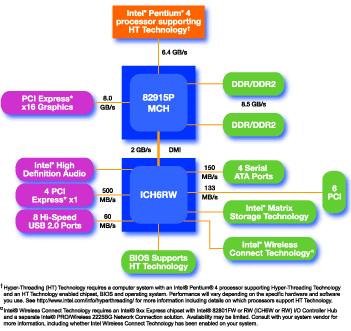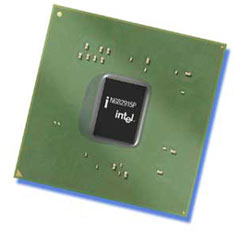The 915P, along with its sister product the 915G, is the
more mainstream of Intel's first Socket 775 chipsets, offering motherboard
manufacturers considerable flexibility in implementing the features it supports.
These chipsets support only socket-755 Pentium 4 processors at front-side bus
speeds of 533 and 800MHz, incidently. Subsequent to this release, the 925XE
brought in support for 1066MHz bus processors, but that is beyond the scope of
this review at the moment.

The 915 chipset supports both DDR-2 and the DDR memory
standard, both in dual-channel. This allows for a slightly easier upgrade path
for current users, who would otherwise be faced with the daunting necessity of
upgrading processor, motherboard and memory. Intel
915-based boards can use both types of memory, along the lines of SIS's dual
SDRAM\DDR-SDRAM chipsets of a few years ago. This would seem to be an obvious
user-friendly step to take, but it has only been implemented by a few
manufacturers.
 Though the Intel 915 chipset is supposed
to be PCI Express or integrated graphics only, several motherboard manufacturers
have already introduced 915-based boards with both an AGP and a PCI Express
slot. This is achieved by linking the AGP slot to the PCI-bus, since the chipset
lacks any provision for a dedicated AGP bus. As you would expect, this limits
the bandwidth available to AGP cards on these boards considerably and can hobble
their performance. For an example of this, see PCSTATS review of the Albatron PX915P-AGPE motherboard which includes one of
these ersatz AGP slots.
Though the Intel 915 chipset is supposed
to be PCI Express or integrated graphics only, several motherboard manufacturers
have already introduced 915-based boards with both an AGP and a PCI Express
slot. This is achieved by linking the AGP slot to the PCI-bus, since the chipset
lacks any provision for a dedicated AGP bus. As you would expect, this limits
the bandwidth available to AGP cards on these boards considerably and can hobble
their performance. For an example of this, see PCSTATS review of the Albatron PX915P-AGPE motherboard which includes one of
these ersatz AGP slots.
The 915 chipset uses the ICH6 Southbridge (see below for
more details) and as such supports Serial ATA-150 and PCI Express I/O slots, as
well as the typical set of USB 2.0 and other inputs. Actual implementation of
these depends on the individual manufacturers.
The main version of this chipset is the 915P, but in
keeping with the mainstream sales target, a variant (915G) supports integrated
Intel graphics. The integrated graphics engine is a new one, Intel's GMA
(Graphics Media Accelerator) 900. While this is light-years better than the
previous Intel 'extreme' integrated graphics chip, which was anything but
extreme, it's still not a good performer with today's games.
